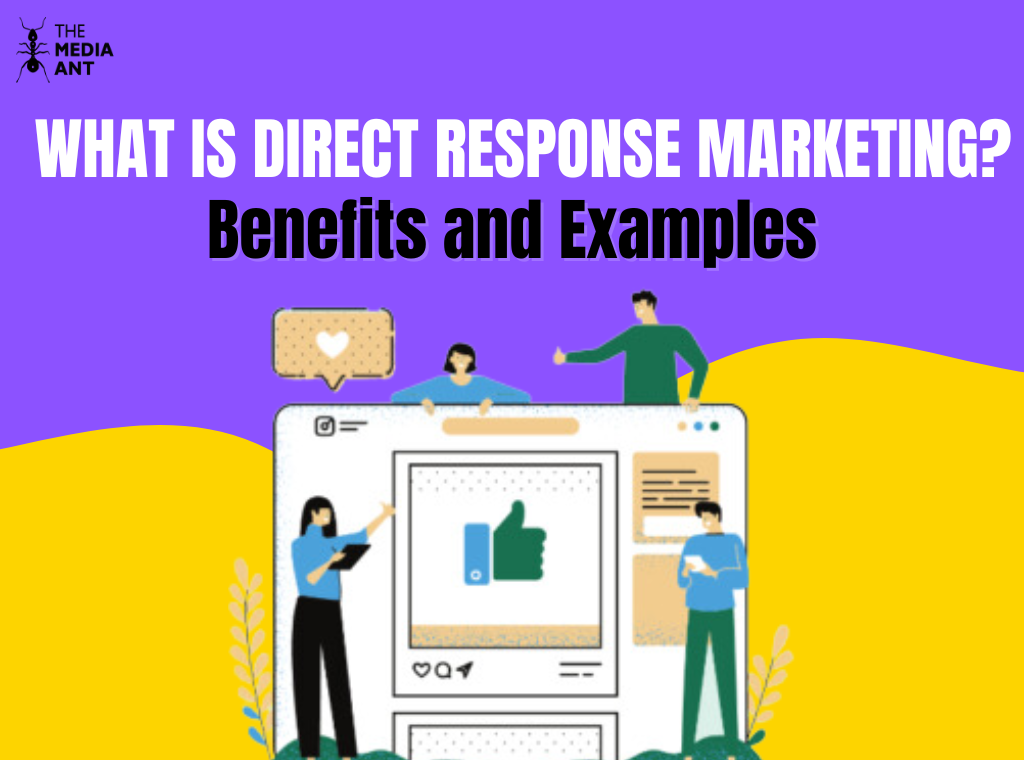Direct response marketing is an active and outcome-oriented approach that enables businesses to prompt immediate action from their target audience. In a saturated marketing landscape, direct response marketing distinguishes itself by its ability to elicit a specific response, such as a purchase, service sign-up, or brand interaction. This proactive tactic not only encourages direct engagement but also allows businesses to assess the impact of their campaigns in real-time. In this blog, we will examine the core principles of direct response marketing, explore its numerous advantages, and analyze real-life instances that demonstrate its effectiveness in delivering tangible outcomes for businesses of any scale.
What is Direct Response Marketing?
Direct response marketing is a method designed to incite an instant reaction or feedback from the intended audience. It consists of sending tailored messages through different platforms like email, social media, or direct mail, including explicit calls-to-action (CTAs). In contrast to conventional marketing strategies that concentrate on establishing brand recognition, direct response marketing aims to provoke a particular and quantifiable reaction, such as completing a purchase, submitting a form, or subscribing to a newsletter. Through the use of personalized communication, enticing deals, and strategic timing, direct response marketing strives to stimulate immediate interaction and conversions, all while allowing companies to monitor and evaluate the efficiency of their campaigns in real-time.
Key Elements of Direct Response Marketing
Direct response marketing is a strategic approach aimed at eliciting an immediate response or action from the audience. It typically involves a direct call to action and employs various elements to engage, persuade, and prompt the audience to take the desired action. Here are the key elements of direct response marketing:
1) Clear Call to Action (CTA)
A crucial aspect of direct response marketing is having a clear and compelling call to action. This guides the audience towards a specific action, increasing the chances of a positive response.
2) Measurable Responses
Direct response campaigns should be designed to provide measurable data for marketers to assess their success. This data-driven approach helps in making informed decisions for future campaigns.
3) Targeted Audience
Precise targeting is essential in direct response marketing to reach the most relevant audience. By doing so, marketers can increase the likelihood of a positive and immediate response from their target audience.
4) Personalization
Personalizing messages based on individual preferences and characteristics can enhance engagement and create a more direct connection between the brand and the consumer.
5) Follow-Up
Implementing a systematic follow-up process is crucial for nurturing leads and turning initial responses into long-term relationships. This ensures continued engagement beyond the initial interaction.
Benefits of Direct Response Marketing
Direct response marketing provides numerous advantages for businesses seeking to interact with their target audience and encourage action. Some of the main benefits are:
1. Measurable Outcomes
Direct response marketing initiatives are crafted to prompt a specific reaction from the audience, whether it involves making a purchase, subscribing to a newsletter, or downloading an e-book. This facilitates the tracking and evaluation of the campaign’s effectiveness in real-time.
2. Targeted Strategy
Direct response marketing empowers businesses to focus on particular audience segments with tailored messages. This targeted approach enhances the relevance of marketing communications, resulting in higher response and conversion rates.
3. Cost-Efficiency
In comparison to traditional advertising methods such as television or print ads, direct response marketing can be more economical. Businesses can engage their target audience through channels like email, social media, or online advertising without the need for substantial investments in broad-reaching campaigns.
4. Immediate Feedback
A key advantage of direct response marketing is its capacity to elicit an immediate response from the audience. Whether it involves clicking on a link, completing a form, or making a purchase, direct response campaigns are structured to spur action in the present moment.
5. Cultivating Customer Relationships
Direct response marketing enables businesses to directly interact with their audience and foster relationships over time. By delivering personalized messages and offers, businesses can nurture leads and transform them into loyal customers.
6. Adaptability and Responsiveness
Direct response marketing campaigns can be swiftly modified and fine-tuned based on real-time data and feedback. This adaptability empowers businesses to optimize their campaigns for improved outcomes and address evolving market conditions or customer preferences.
7. Trackable ROI
Direct response marketing campaigns provide businesses with the ability to accurately track the return on investment (ROI) for their marketing efforts. By analyzing metrics such as click-through rates, conversion rates, and cost per acquisition, businesses can assess the effectiveness of their campaigns and make data-driven decisions to enhance performance.
8. Ability to Test and Iterate
Direct response marketing is conducive to testing and experimentation. Businesses can conduct tests using different messages, offers, and targeting strategies to determine what resonates best with their audience. This iterative approach enables businesses to continuously optimize their campaigns for improved results.
In summary, direct response marketing offers businesses a strategic and cost-effective means to engage with their audience, prompt action, and achieve measurable outcomes. By utilizing targeted messaging, immediate responses, and insights derived from data analysis, businesses can foster more meaningful interactions with their customers and ultimately drive growth and profitability.
Direct Response Marketing vs Branding
Direct response marketing and branding have distinct purposes and strategies, but they can work together harmoniously in a comprehensive marketing approach. Here is a breakdown of the main contrasts between the two:
1) Purpose
1. Direct Response Marketing
The primary objective of direct response marketing is to prompt an immediate response or action from the audience, such as making a purchase, subscribing to a newsletter, or requesting more information. It focuses on achieving measurable results in the short term.
2. Branding
Conversely, branding concentrates on shaping perceptions, emotions, and attitudes towards a brand over the long term. Its aim is to establish recognition, loyalty, and trust among consumers, often through consistent messaging, visual identity, and storytelling.
2) Timing
1. Direct Response Marketing
Direct response marketing typically involves targeted, short-term campaigns designed to elicit immediate responses from the audience. These campaigns often include specific call-to-actions and are evaluated based on their immediate impact.
2. Branding
Branding efforts are ongoing and long-term. They concentrate on creating a strong, enduring brand presence in the minds of consumers, which requires time to develop and maintain.
3) Metrics
1. Direct Response Marketing
Direct response marketing relies on measurable metrics such as click-through rates, conversion rates, and return on investment (ROI) to assess the effectiveness of campaigns. These metrics provide concrete data on the success of specific marketing efforts.
2. Branding
Branding efforts are often evaluated through less tangible metrics such as brand awareness, brand perception, and brand loyalty. While these metrics may be more challenging to quantify, they are crucial for understanding the overall health and strength of a brand.
4) Messaging
1. Direct Response Marketing
Direct response marketing messages are typically designed to elicit an immediate response from the audience. These messages are action-oriented and often include specific offers, incentives, or calls-to-action. The main objective is to prompt the audience to take immediate action.
2. Branding
On the other hand, branding messages are more focused on conveying the values, personality, and unique selling proposition of a brand. These messages aim to establish an emotional connection with consumers and create a distinct identity and positioning in the market. The primary goal is to build brand awareness and recognition.
5) Audience Targeting
1. Direct Response Marketing
Direct response marketing involves targeted messaging that is tailored to specific audience segments based on demographics, interests, or behavior. The aim is to reach the right audience with the right message at the right time, in order to maximize response rates and drive desired actions.
2. Branding
While branding efforts may also involve targeted messaging, they often have a broader scope. The objective is to reach a wide audience and build brand awareness and recognition across diverse demographics.
Effective Channels for Direct Response Marketing
Direct response marketing can be implemented using a range of channels, which are determined by the target audience, objectives, and available resources. Below are a few effective channels for executing direct response marketing strategies:
Direct Mail
Sending customized messages through postal mail to directly connect with the intended recipients.
Email Marketing
Email marketing involves sending personalized emails to a specific audience, accompanied by compelling calls to action, taking advantage of the instant nature of digital communication.
Social Media
Developing compelling content and advertisements aimed at eliciting immediate reactions and engagement from the viewers.
Display Advertising
Using visually captivating advertisements on websites to prompt immediate action, frequently through interactive elements.
Event Marketing
Event Marketing involves creating interactive experiences during events or promotions in order to stimulate immediate engagement.
Affiliate Marketing
Collaborating with affiliates to drive targeted traffic and sales through a network of partners.
8 Examples of Direct Response Marketing
Here are eight instances of direct response marketing campaigns:
1. Email Marketing Campaign with Limited-Time Offer
A retail company distributes an email to its subscriber list, presenting a limited-time discount on selected products. The email contains a clear call-to-action (CTA) that urges recipients to click through to the website and make a purchase using a unique promo code.
2. Google Search Ads for Online Course Enrollment
An educational institution initiates a Google search advertising campaign that targets keywords associated with online courses. The ads emphasize the advantages of the courses and incorporate a compelling CTA to enroll or request more information, guiding users to a dedicated landing page with a registration form.
3. Facebook Retargeting Ad for Abandoned Cart Recovery
An e-commerce company retargets individuals who abandoned their shopping carts on their website by displaying personalized Facebook ads showcasing the products they left behind. The ads feature a CTA that encourages recipients to complete their purchase, leading them directly to the checkout page.
4. Direct Mail Postcard with Exclusive Offer
A subscription-based service sends out direct mail postcards to a specific list of potential customers. The postcards include an enticing offer, such as a free trial or discount, along with a unique promo code that can be redeemed when signing up online or over the phone.
5. SMS Marketing Campaign for Limited-Time Sale Alert
A clothing retailer utilizes text messages to inform its SMS subscriber list about an exclusive flash sale offering time-limited discounts on specific items. The SMS message contains a call-to-action guiding recipients to either shop online or visit the nearest store before the sale concludes.
6. Interactive Quiz for Lead Generation
A software company creates an interactive quiz on its website to help businesses assess their marketing effectiveness. At the end of the quiz, participants are prompted to enter their email address to receive personalized insights and recommendations, effectively generating leads for the company.
7. Television Infomercial with Toll-Free Contact Number
A fitness equipment producer broadcasts a direct response television infomercial showcasing its newest product. The infomercial features testimonials, product demonstrations, and a toll-free phone number for viewers to dial and place orders or request additional information.
8. Affiliate Marketing Collaboration with Influencers
A cosmetics brand partners with influencers to endorse its latest skincare collection through affiliate marketing collaborations. Influencers produce content showcasing the products and distribute exclusive discount codes to their followers, earning commissions for each sale generated via their referral links.
Conclusion
Direct Response Marketing is a powerful and flexible strategy that establishes a direct link with the audience through tailored, personalized, and action-driven campaigns. Its capacity to produce instant outcomes and enable quantifiable engagements makes it a valuable method in the constantly changing marketing environment.
FAQs on Direct Response Marketing
1. How does direct response marketing differ from traditional marketing?
Direct response marketing places emphasis on prompt and quantifiable actions, whereas traditional marketing concentrates on establishing enduring brand recognition.
2. How can I measure the effectiveness of my direct response marketing efforts?
Employ key performance indicators (KPIs) such as conversion rates, click-through rates, and response rates to assess the effectiveness of your campaigns.
3. What are some best practices for creating a direct response marketing campaign?
It is essential to precisely articulate your objectives, craft captivating calls-to-action, focus on the appropriate audience, customize messages, and implement a structured follow-up procedure to ensure continuous engagement.
4. Is direct response marketing suitable for all types of businesses?
The effectiveness of this approach varies depending on the specific objectives and characteristics of the target audience. To achieve the best possible outcomes, it is essential to customize the strategy according to your individual business context.





